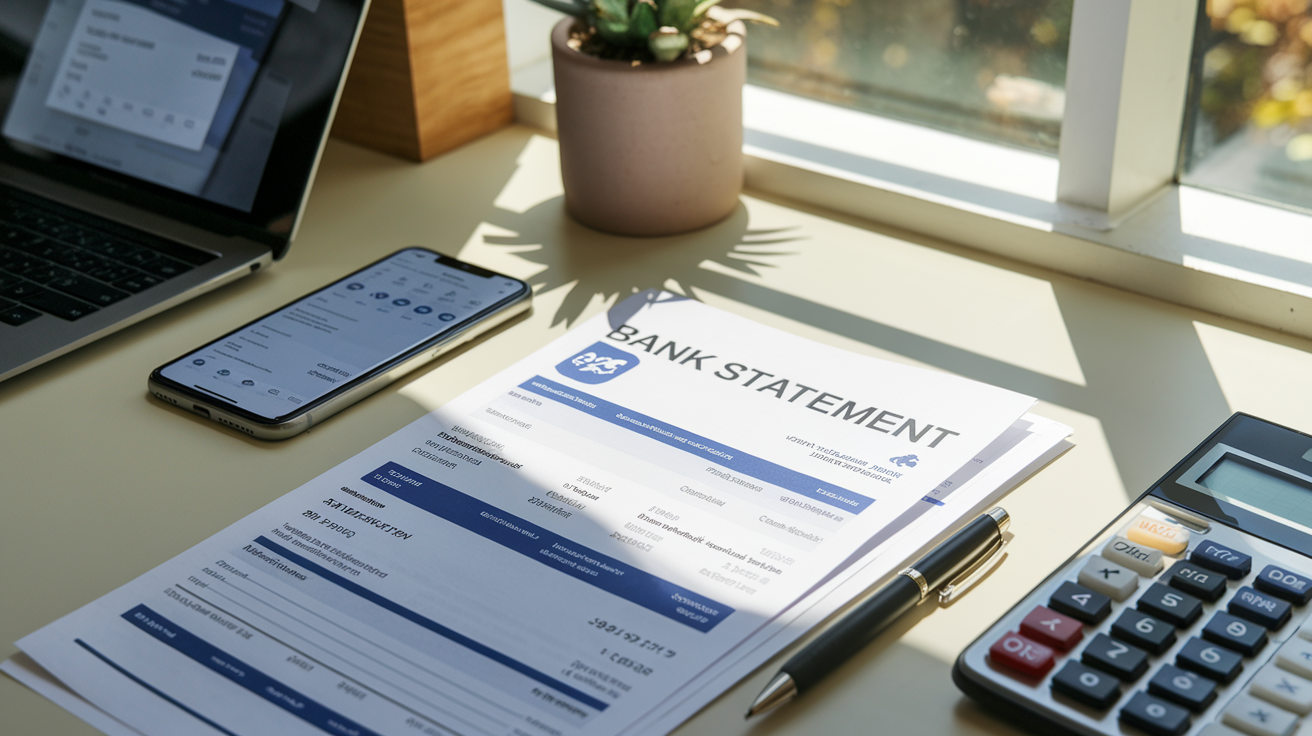
Are you tired of jumping through hoops to prove your income? 🏃♂️💨 In today’s financial landscape, demonstrating your earnings can feel like a daunting task. Whether you’re applying for a loan, renting an apartment, or seeking government assistance, the demand for solid proof of income is ever-present. But what if there was a simple and reliable way to showcase your financial stability?
Enter the bank statement – your golden ticket to hassle-free income verification. 🏦💰 This powerful document not only provides a comprehensive snapshot of your financial health but also serves as a trusted source of information for lenders, landlords, and various institutions. In this blog post, we’ll dive deep into the world of bank statement income verification, exploring why it’s become the go-to method for proving your earnings and how you can effectively use it to your advantage.
From understanding what should be included in your bank statements to learning the ins and outs of the verification process, we’ve got you covered. We’ll also explore alternative methods and common proof of income documents, ensuring you’re well-equipped to handle any financial scrutiny that comes your way. So, buckle up as we unravel the mysteries of bank statement income verification and empower you to take control of your financial narrative! 💪📊
What is Bank Statement Income Verification?
Definition of Bank Statement Income Verification
Bank statement income verification is a process used by lenders, landlords, and other entities to assess an individual’s financial stability and income. This method involves analyzing bank statements to confirm a person’s income, especially when traditional income verification methods may not be applicable.
Key Components of Bank Statement Income Verification
-
Statement Analysis: Reviewers examine deposits, withdrawals, and balance trends.
-
Income Patterns: Regular deposits are identified to establish consistent income.
-
Time Frame: Typically, 3-12 months of statements are required.
-
Deposit Categorization: Distinguishing between income and non-income deposits.
Common Uses
-
Self-employed individuals
-
Freelancers
-
Gig economy workers
-
Rental property owners
Advantages and Disadvantages
| Advantages | Disadvantages |
|---|---|
| Flexibility for non-traditional earners | May not capture all income sources |
| Provides a comprehensive financial picture | Requires detailed financial record-keeping |
| Can reveal spending habits and financial responsibility | Privacy concerns for some applicants |
Bank statement income verification offers a practical alternative to traditional proof of income methods, particularly for those with variable or non-traditional income sources. It allows for a more nuanced assessment of an individual’s financial situation, taking into account the complexities of modern work arrangements and income streams.
How to show proof of income without bank statements?
To make a bank statement for proof of income, you actually don’t need to create one. Instead, you can use alternative documents like pay stubs, tax returns, or employer letters. These are widely accepted and can effectively demonstrate your income without relying on bank statements. Always check with the requesting party to ensure they accept these alternatives.
Common Proof of Income Documents

Pay Stubs
Pay stubs are one of the most common and straightforward proof of income documents. They provide a detailed breakdown of an employee’s earnings and deductions for a specific pay period.
-
Regular wages
-
Overtime pay
-
Bonuses or commissions
-
Tax withholdings
-
Benefit deductions
Tax Returns
Tax returns offer a comprehensive view of an individual’s annual income, making them a reliable source for income verification.
| Tax Form | Used For |
|---|---|
| 1040 | Individual income tax return |
| 1099 | Independent contractors or self-employed individuals |
| W-2 | Employees’ annual wages |
Employment Verification Letter
An employment verification letter, also known as a proof of employment letter, is a document provided by an employer confirming an individual’s employment status and income.
1099 Forms
For independent contractors, freelancers, or self-employed individuals, 1099 forms serve as crucial proof of income documents. These forms report various types of income other than wages, salaries, and tips.
Profit and Loss Statements
Self-employed individuals or small business owners often use profit and loss statements to demonstrate their income. These documents provide a summary of revenues, costs, and expenses over a specific period.
Now that we’ve explored various proof of income documents, let’s examine why bank statements are particularly effective for income verification.
Why Use Bank Statement for Proof of Income Verification?
Reliability and Accuracy
Bank statements provide a comprehensive and accurate picture of an individual’s financial situation. They offer a detailed record of all transactions, including deposits, withdrawals, and recurring payments. This level of detail makes bank statements a highly reliable source for income verification.
| Advantage | Description |
|---|---|
| Objectivity | Bank statements are official documents, free from personal bias |
| Completeness | Shows all financial transactions over a specific period |
| Timeliness | Provides up-to-date information on income and expenses |
Versatility for Various Income Types
One of the key benefits of using bank statements for income verification is their versatility. They can effectively demonstrate income for:
-
Self-employed individuals
-
Freelancers with irregular income
-
Rental property owners
-
Individuals with multiple income sources
Ease of Obtaining and Submitting
In today’s digital age, accessing and submitting bank statements has become increasingly convenient:
-
Most banks offer online portals for easy statement downloads
-
Statements can be quickly emailed or uploaded to verification systems
-
Multiple months of statements can be obtained with just a few clicks
Enhanced Fraud Prevention
Bank statements play a crucial role in preventing income fraud:
-
They’re difficult to falsify due to their official nature
-
Verification agencies can cross-reference with banking institutions
-
Patterns of deposits and withdrawals are hard to fabricate consistently
Now that we understand the advantages of using bank statements for income verification, let’s explore what specific information should be included in these statements to ensure they meet verification requirements.
What Should Be Included on the Bank Statements
A. Types of income to show
When preparing bank statements for proof of income, it’s crucial to include various types of income to provide a comprehensive picture of your financial situation. Here are the key income types to highlight:
-
Regular employment income
-
Self-employment earnings
-
Investment income (dividends, interest)
-
Rental income
-
Pension or retirement benefits
-
Government assistance (e.g., Social Security)
-
Alimony or child support payments
| Income Type | Description | Frequency |
|---|---|---|
| Regular employment | Salary or wages from a job | Bi-weekly or monthly |
| Self-employment | Earnings from business or freelance work | Variable |
| Investment | Returns from stocks, bonds, or savings accounts | Quarterly or annually |
| Rental | Income from property rentals | Monthly |
| Pension/Retirement | Regular payments from retirement accounts | Monthly |
| Government assistance | Social Security or other benefits | Monthly |
| Alimony/Child support | Court-ordered payments | Monthly |
Ensure that all these income sources are clearly reflected in your bank statements to provide a comprehensive view of your financial stability.
B. What To Avoid Including
While it’s important to showcase your income, certain items should be avoided when presenting bank statements for income verification:
-
Personal expenses unrelated to income
-
Large cash deposits without clear sources
-
Transfers between personal accounts
-
Bounced checks or overdraft fees
-
Non-recurring income (e.g., one-time gifts)
By focusing on relevant income sources and avoiding unnecessary or potentially questionable entries, you can create a clear and professional bank statement that effectively demonstrates your income for verification purposes.
FAQs about Bank Statement Income Verification
FAQs about Bank Statement Income Verification
Q1: How many months of bank statements are typically required?
Most lenders or landlords require 2-3 months of recent bank statements for income verification. However, some may ask for up to 6 months, especially for self-employed individuals or those with irregular income.
Q2: Can I use online bank statements for income verification?
Yes, online bank statements are generally acceptable. Ensure they include all necessary information such as your name, account number, transaction details, and bank logo. Some institutions may require official stamped copies.
Q3: What if my income varies month to month?
For individuals with variable income, lenders often look at average income over a longer period. They may request additional months of statements or other supporting documents.
| Income Type | Typical Verification Period |
|---|---|
| Regular | 2-3 months |
| Variable | 3-6 months |
| Seasonal | 12 months |
Q4: Are there alternatives to bank statements for income verification?
Yes, alternatives include:
-
Pay stubs
-
Tax returns
-
W-2 forms
-
1099 forms
-
Employer letters
Q5: How do lenders analyze bank statements for income verification?
Lenders typically:
-
Calculate average monthly income
-
Identify regular deposits
-
Look for consistent income patterns
-
Check for sufficient funds to cover expenses
-
Analyze spending habits
Bank statements serve as a reliable and comprehensive method for verifying income, offering a clear picture of an individual’s financial situation. By showcasing consistent deposits, regular income patterns, and overall financial health, these documents provide lenders and other entities with the confidence they need to make informed decisions.
Remember, when using bank statements for income verification, ensure they are recent, complete, and accurately reflect your financial status. While alternative proof of income methods exist, bank statements remain a preferred choice for many due to their thoroughness and reliability. Whether you’re applying for a loan, renting a property, or need to demonstrate your income for any other reason, a well-prepared bank statement can be your key to success.



